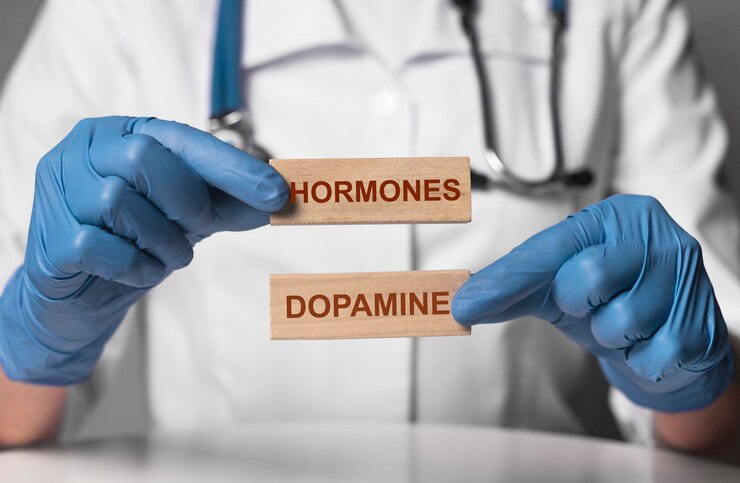- 16 March 2023
- 109
Craving Control: The Role of Dopamine in Addiction and Recovery

Are you tired of constantly giving in to your cravings and feeling like you have no control? Do you wonder why addiction seems to take hold so easily? It turns out that the answer lies within our brains, specifically with a neurotransmitter called dopamine. In this blog post, we’ll explore the role of dopamine in addiction and recovery, providing insights into how it can impact our behavior and what steps we can take to regain control. So grab a cup of coffee and join us as we delve into the fascinating world of craving control!
What is dopamine and what does it do?
Dopamine is a neurotransmitter that helps control the brain’s reward and pleasure centers. Dopamine is released when we experience something pleasurable, like eating good food, having sex, or using drugs. This release of dopamine creates feelings of pleasure and satisfaction, which motivates us to repeat the behavior that caused it.
People who struggle with addiction have difficulty controlling their impulses and often feel compelled to seek out substances or activities that will give them a dopamine rush, even if they are aware of the negative consequences. This can lead to destructive behaviors like excessive drinking, drug use, gambling, and risky sexual behavior.
While dopamine is essential for experiencing pleasure, too much of it can be detrimental. When someone overindulges in drugs or alcohol, for example, they may damage the dopamine receptors in their brain, making it harder for them to feel pleasure from other activities. This can lead to further addiction as they try to chase that initial high.
If you’re struggling with addiction, it’s important to seek help from a treatment center that can address the underlying causes of your disorder and help you develop healthy coping mechanisms. Recovery is possible— contact us today to learn more about our program at The Ranch Tennessee.
How does dopamine contribute to addiction?
Dopamine is a neurotransmitter that plays a key role in the brain’s reward system. This system is responsible for regulating our response to pleasurable activities, such as eating, sex, and drugs. When we engage in an activity that releases dopamine, we feel a sense of pleasure or satisfaction.
This release of dopamine is what reinforces our behavior and makes us want to repeat the experience. In the case of addiction, the repeated use of drugs or other behaviors leads to an increase in dopamine release. Over time, the brain becomes less sensitive to dopamine, and we need more of the substance or activity to get the same feeling of pleasure. This is called tolerance.
Tolerance leads to increased drug use, which can lead to addiction. Addiction is characterized by compulsive drug use despite negative consequences. People with addiction often continue using substances even though it causes problems in their lives.
Dopamine plays a major role in addiction because it is involved in both the reinforcing effects of drugs and the development of tolerance. When someone is addicted to a substance, they are essentially chasing the feeling of pleasure that they got when they first used the drug. However, as tolerance develops, they need to use more and more of the substance to get this feeling. This can lead to dangerous levels of drug use and put them at risk for overdosing.
What role does dopamine play in recovery?
As with many things related to addiction, the role of dopamine in recovery is complex and not fully understood. However, there is evidence that dopamine plays a significant role in both the development of addiction and the process of recovery.
Dopamine is a neurotransmitter that is involved in pleasure and reward seeking behavior. When we do something that feels good, dopamine is released in the brain, which reinforces the behavior. This reinforcement system is what leads to addictive behaviors – as we seek out activities that will release dopamine, we become more likely to repeat those behaviors.
In recovery, it is important to find healthy activities that can replace the addictive behaviors and provide a sense of satisfaction. For some people, this may mean participating in activities that release dopamine, such as exercise or spending time with friends and family. Others may find that they need to avoid trigger activities altogether. Either way, understanding the role of dopamine in addiction can help you make choices that support your recovery.
How can I manage my dopamine levels?
It is well-known that dopamine plays a role in addiction and recovery. However, what is not as well-known is how to manage dopamine levels in order to control cravings and prevent relapse.
There are two main ways to manage dopamine levels: through diet and through supplements.
Diet is by far the most important factor in controlling dopamine levels. Foods that are high in protein and healthy fats (such as avocados, nuts, and salmon) help to increase dopamine levels, while processed foods and sugars lower them. Therefore, it is important to eat a balanced diet that includes plenty of protein and healthy fats, and to avoid processed foods and sugar as much as possible.
In addition to diet, there are certain supplements that can help to increase dopamine levels. The most popular supplement for this purpose is L-Tyrosine, which is an amino acid that helps to produce dopamine. Other supplements that have been shown to be effective in increasing dopamine levels include omega-3 fatty acids, magnesium, and green tea extract.
Conclusion
From this article, we have learned the role of dopamine in controlling cravings and the specifics of addiction recovery. We now know that dopamine is a key neurotransmitter in driving cravings and behavior related to drugs or alcohol use. Additionally, it plays an important role in enabling individuals to sustain abstinence during treatment and reduce their risk of relapse. In sum, understanding how dopamine works can help us better understand addiction and provide new strategies for managing cravings.

